Multiculturalism and Australian Society
VerifiedAdded on 2021/04/17
|9
|2709
|34
AI Summary
This assignment provides an in-depth analysis of multiculturalism in Australian society, highlighting its significance and challenges. The discussion revolves around the movie 'They're a Weird Mob', which portrays the struggles of a Italian immigrant in Australia and how it contributed to the development of multiculturalism in the country. It also mentions various legislations passed by the Australian government to promote equality and prevent discrimination.
Contribute Materials
Your contribution can guide someone’s learning journey. Share your
documents today.
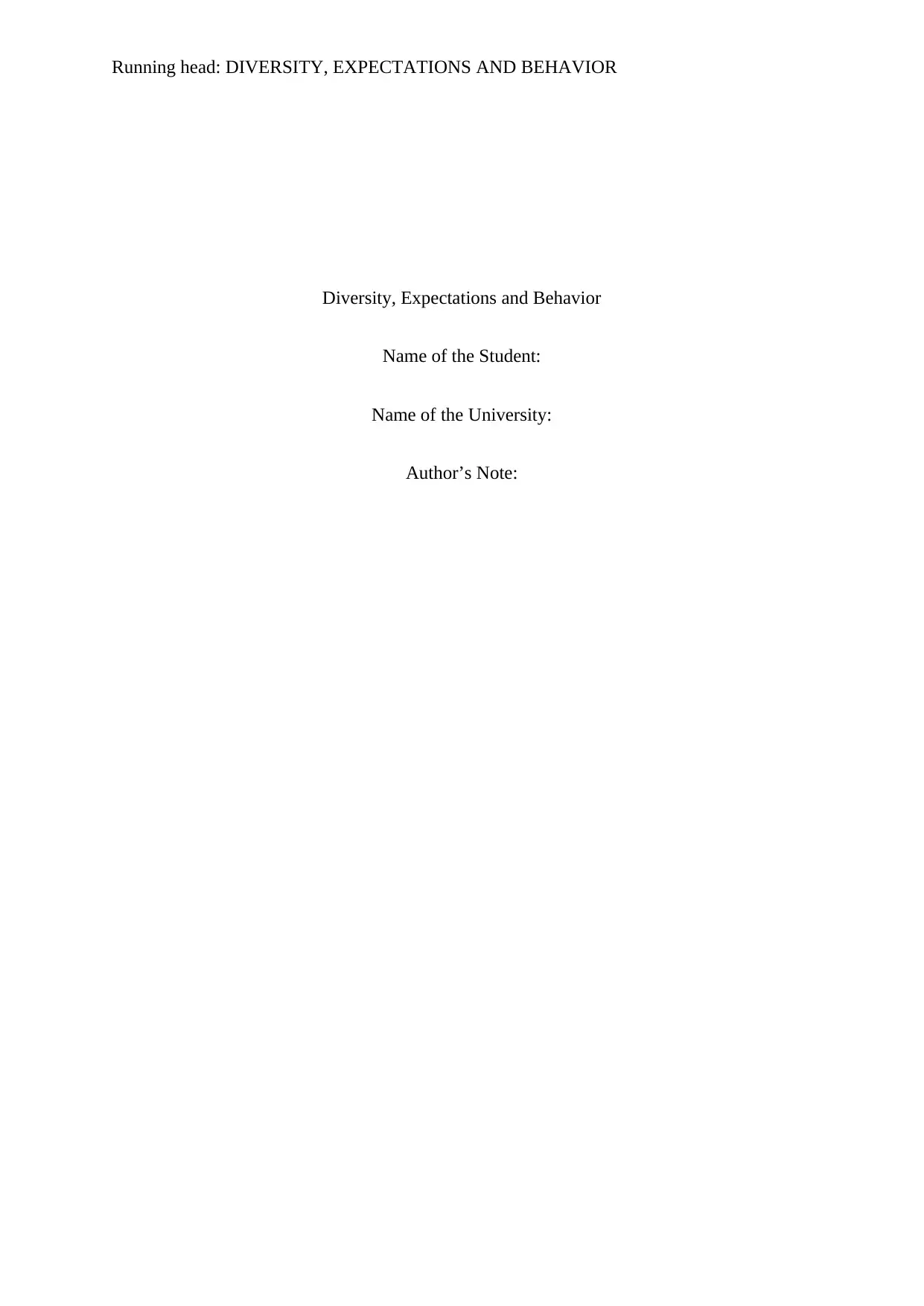
Running head: DIVERSITY, EXPECTATIONS AND BEHAVIOR
Diversity, Expectations and Behavior
Name of the Student:
Name of the University:
Author’s Note:
Diversity, Expectations and Behavior
Name of the Student:
Name of the University:
Author’s Note:
Secure Best Marks with AI Grader
Need help grading? Try our AI Grader for instant feedback on your assignments.
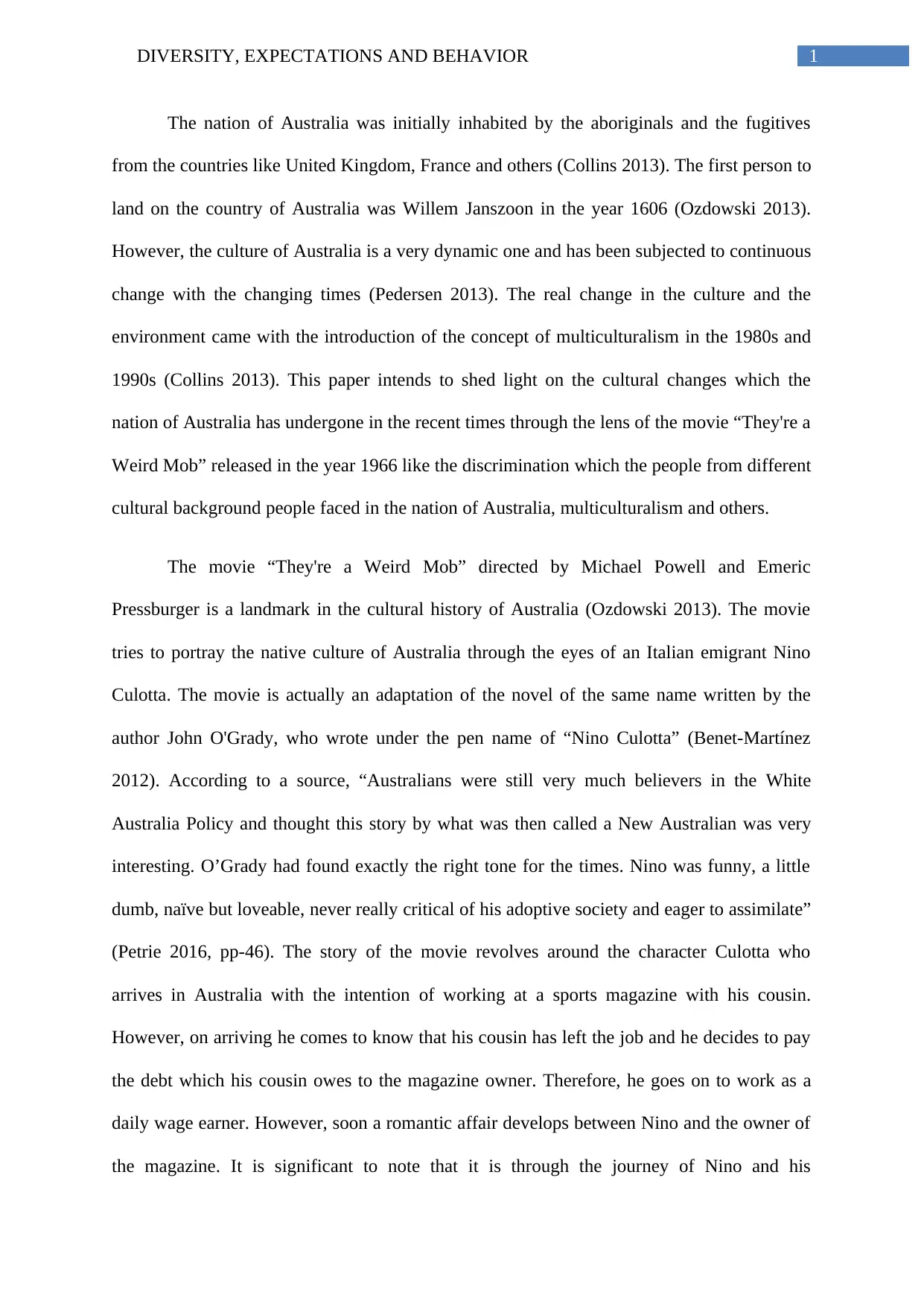
1DIVERSITY, EXPECTATIONS AND BEHAVIOR
The nation of Australia was initially inhabited by the aboriginals and the fugitives
from the countries like United Kingdom, France and others (Collins 2013). The first person to
land on the country of Australia was Willem Janszoon in the year 1606 (Ozdowski 2013).
However, the culture of Australia is a very dynamic one and has been subjected to continuous
change with the changing times (Pedersen 2013). The real change in the culture and the
environment came with the introduction of the concept of multiculturalism in the 1980s and
1990s (Collins 2013). This paper intends to shed light on the cultural changes which the
nation of Australia has undergone in the recent times through the lens of the movie “They're a
Weird Mob” released in the year 1966 like the discrimination which the people from different
cultural background people faced in the nation of Australia, multiculturalism and others.
The movie “They're a Weird Mob” directed by Michael Powell and Emeric
Pressburger is a landmark in the cultural history of Australia (Ozdowski 2013). The movie
tries to portray the native culture of Australia through the eyes of an Italian emigrant Nino
Culotta. The movie is actually an adaptation of the novel of the same name written by the
author John O'Grady, who wrote under the pen name of “Nino Culotta” (Benet-Martínez
2012). According to a source, “Australians were still very much believers in the White
Australia Policy and thought this story by what was then called a New Australian was very
interesting. O’Grady had found exactly the right tone for the times. Nino was funny, a little
dumb, naïve but loveable, never really critical of his adoptive society and eager to assimilate”
(Petrie 2016, pp-46). The story of the movie revolves around the character Culotta who
arrives in Australia with the intention of working at a sports magazine with his cousin.
However, on arriving he comes to know that his cousin has left the job and he decides to pay
the debt which his cousin owes to the magazine owner. Therefore, he goes on to work as a
daily wage earner. However, soon a romantic affair develops between Nino and the owner of
the magazine. It is significant to note that it is through the journey of Nino and his
The nation of Australia was initially inhabited by the aboriginals and the fugitives
from the countries like United Kingdom, France and others (Collins 2013). The first person to
land on the country of Australia was Willem Janszoon in the year 1606 (Ozdowski 2013).
However, the culture of Australia is a very dynamic one and has been subjected to continuous
change with the changing times (Pedersen 2013). The real change in the culture and the
environment came with the introduction of the concept of multiculturalism in the 1980s and
1990s (Collins 2013). This paper intends to shed light on the cultural changes which the
nation of Australia has undergone in the recent times through the lens of the movie “They're a
Weird Mob” released in the year 1966 like the discrimination which the people from different
cultural background people faced in the nation of Australia, multiculturalism and others.
The movie “They're a Weird Mob” directed by Michael Powell and Emeric
Pressburger is a landmark in the cultural history of Australia (Ozdowski 2013). The movie
tries to portray the native culture of Australia through the eyes of an Italian emigrant Nino
Culotta. The movie is actually an adaptation of the novel of the same name written by the
author John O'Grady, who wrote under the pen name of “Nino Culotta” (Benet-Martínez
2012). According to a source, “Australians were still very much believers in the White
Australia Policy and thought this story by what was then called a New Australian was very
interesting. O’Grady had found exactly the right tone for the times. Nino was funny, a little
dumb, naïve but loveable, never really critical of his adoptive society and eager to assimilate”
(Petrie 2016, pp-46). The story of the movie revolves around the character Culotta who
arrives in Australia with the intention of working at a sports magazine with his cousin.
However, on arriving he comes to know that his cousin has left the job and he decides to pay
the debt which his cousin owes to the magazine owner. Therefore, he goes on to work as a
daily wage earner. However, soon a romantic affair develops between Nino and the owner of
the magazine. It is significant to note that it is through the journey of Nino and his
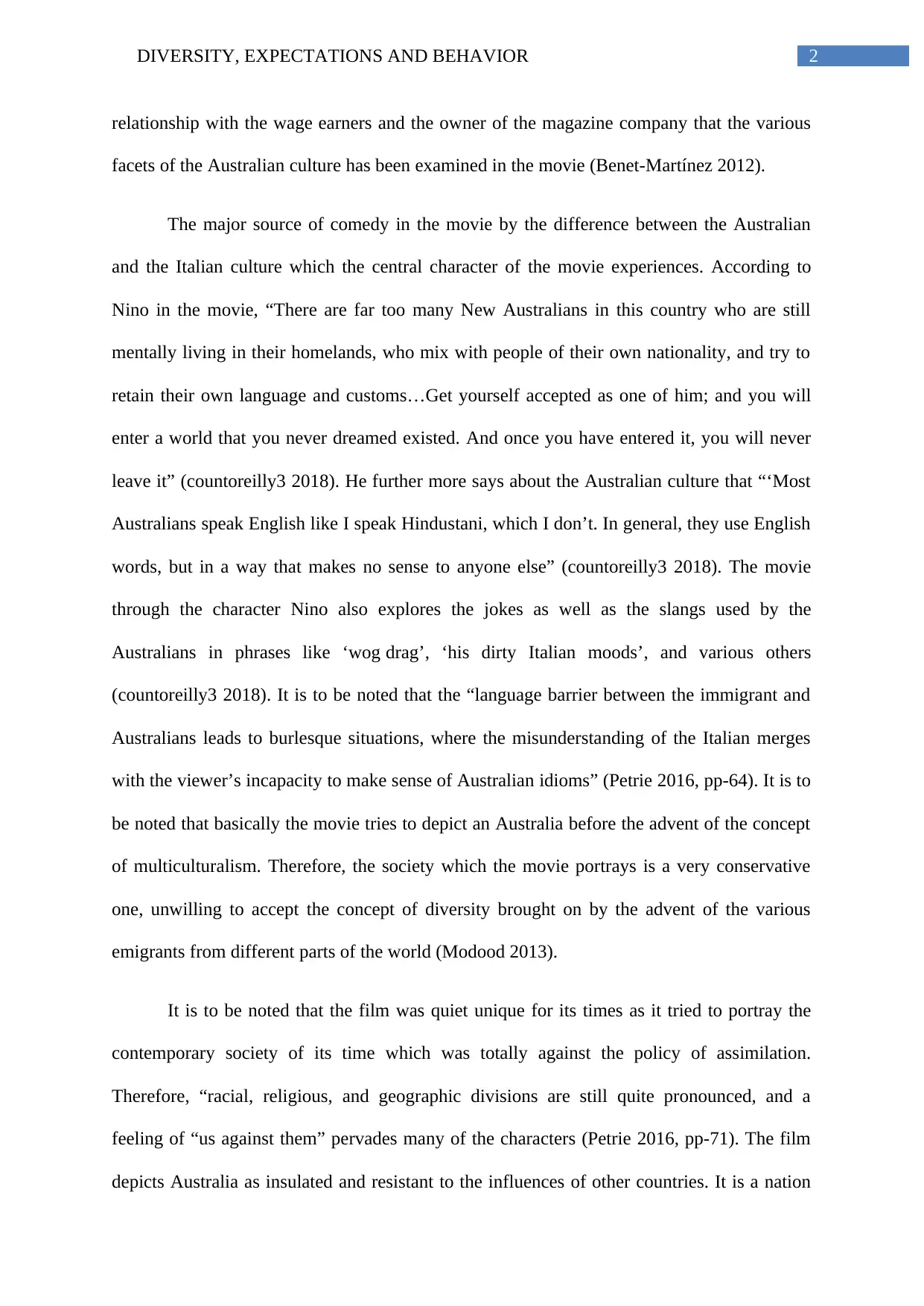
2DIVERSITY, EXPECTATIONS AND BEHAVIOR
relationship with the wage earners and the owner of the magazine company that the various
facets of the Australian culture has been examined in the movie (Benet-Martínez 2012).
The major source of comedy in the movie by the difference between the Australian
and the Italian culture which the central character of the movie experiences. According to
Nino in the movie, “There are far too many New Australians in this country who are still
mentally living in their homelands, who mix with people of their own nationality, and try to
retain their own language and customs…Get yourself accepted as one of him; and you will
enter a world that you never dreamed existed. And once you have entered it, you will never
leave it” (countoreilly3 2018). He further more says about the Australian culture that “‘Most
Australians speak English like I speak Hindustani, which I don’t. In general, they use English
words, but in a way that makes no sense to anyone else” (countoreilly3 2018). The movie
through the character Nino also explores the jokes as well as the slangs used by the
Australians in phrases like ‘wog drag’, ‘his dirty Italian moods’, and various others
(countoreilly3 2018). It is to be noted that the “language barrier between the immigrant and
Australians leads to burlesque situations, where the misunderstanding of the Italian merges
with the viewer’s incapacity to make sense of Australian idioms” (Petrie 2016, pp-64). It is to
be noted that basically the movie tries to depict an Australia before the advent of the concept
of multiculturalism. Therefore, the society which the movie portrays is a very conservative
one, unwilling to accept the concept of diversity brought on by the advent of the various
emigrants from different parts of the world (Modood 2013).
It is to be noted that the film was quiet unique for its times as it tried to portray the
contemporary society of its time which was totally against the policy of assimilation.
Therefore, “racial, religious, and geographic divisions are still quite pronounced, and a
feeling of “us against them” pervades many of the characters (Petrie 2016, pp-71). The film
depicts Australia as insulated and resistant to the influences of other countries. It is a nation
relationship with the wage earners and the owner of the magazine company that the various
facets of the Australian culture has been examined in the movie (Benet-Martínez 2012).
The major source of comedy in the movie by the difference between the Australian
and the Italian culture which the central character of the movie experiences. According to
Nino in the movie, “There are far too many New Australians in this country who are still
mentally living in their homelands, who mix with people of their own nationality, and try to
retain their own language and customs…Get yourself accepted as one of him; and you will
enter a world that you never dreamed existed. And once you have entered it, you will never
leave it” (countoreilly3 2018). He further more says about the Australian culture that “‘Most
Australians speak English like I speak Hindustani, which I don’t. In general, they use English
words, but in a way that makes no sense to anyone else” (countoreilly3 2018). The movie
through the character Nino also explores the jokes as well as the slangs used by the
Australians in phrases like ‘wog drag’, ‘his dirty Italian moods’, and various others
(countoreilly3 2018). It is to be noted that the “language barrier between the immigrant and
Australians leads to burlesque situations, where the misunderstanding of the Italian merges
with the viewer’s incapacity to make sense of Australian idioms” (Petrie 2016, pp-64). It is to
be noted that basically the movie tries to depict an Australia before the advent of the concept
of multiculturalism. Therefore, the society which the movie portrays is a very conservative
one, unwilling to accept the concept of diversity brought on by the advent of the various
emigrants from different parts of the world (Modood 2013).
It is to be noted that the film was quiet unique for its times as it tried to portray the
contemporary society of its time which was totally against the policy of assimilation.
Therefore, “racial, religious, and geographic divisions are still quite pronounced, and a
feeling of “us against them” pervades many of the characters (Petrie 2016, pp-71). The film
depicts Australia as insulated and resistant to the influences of other countries. It is a nation
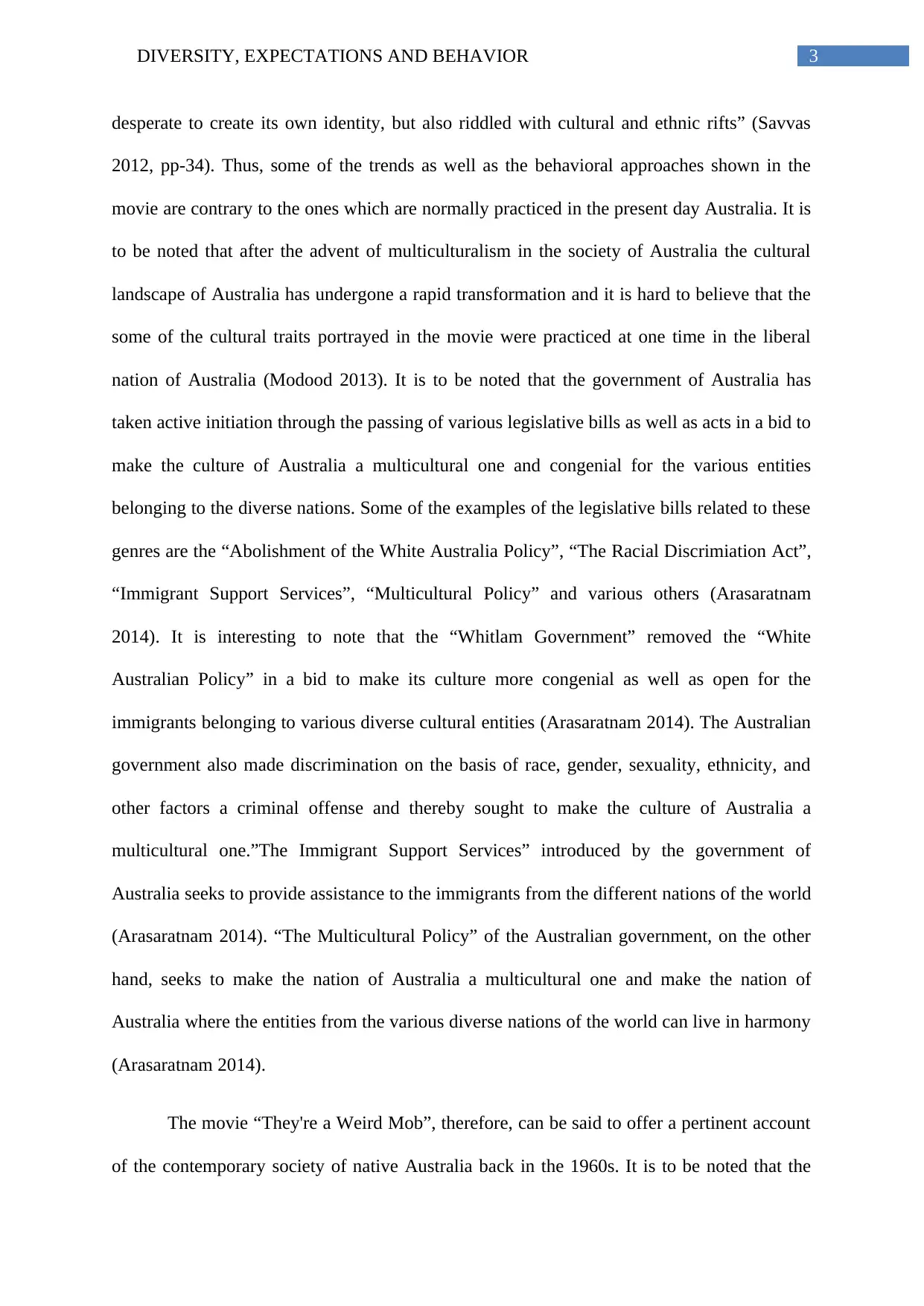
3DIVERSITY, EXPECTATIONS AND BEHAVIOR
desperate to create its own identity, but also riddled with cultural and ethnic rifts” (Savvas
2012, pp-34). Thus, some of the trends as well as the behavioral approaches shown in the
movie are contrary to the ones which are normally practiced in the present day Australia. It is
to be noted that after the advent of multiculturalism in the society of Australia the cultural
landscape of Australia has undergone a rapid transformation and it is hard to believe that the
some of the cultural traits portrayed in the movie were practiced at one time in the liberal
nation of Australia (Modood 2013). It is to be noted that the government of Australia has
taken active initiation through the passing of various legislative bills as well as acts in a bid to
make the culture of Australia a multicultural one and congenial for the various entities
belonging to the diverse nations. Some of the examples of the legislative bills related to these
genres are the “Abolishment of the White Australia Policy”, “The Racial Discrimiation Act”,
“Immigrant Support Services”, “Multicultural Policy” and various others (Arasaratnam
2014). It is interesting to note that the “Whitlam Government” removed the “White
Australian Policy” in a bid to make its culture more congenial as well as open for the
immigrants belonging to various diverse cultural entities (Arasaratnam 2014). The Australian
government also made discrimination on the basis of race, gender, sexuality, ethnicity, and
other factors a criminal offense and thereby sought to make the culture of Australia a
multicultural one.”The Immigrant Support Services” introduced by the government of
Australia seeks to provide assistance to the immigrants from the different nations of the world
(Arasaratnam 2014). “The Multicultural Policy” of the Australian government, on the other
hand, seeks to make the nation of Australia a multicultural one and make the nation of
Australia where the entities from the various diverse nations of the world can live in harmony
(Arasaratnam 2014).
The movie “They're a Weird Mob”, therefore, can be said to offer a pertinent account
of the contemporary society of native Australia back in the 1960s. It is to be noted that the
desperate to create its own identity, but also riddled with cultural and ethnic rifts” (Savvas
2012, pp-34). Thus, some of the trends as well as the behavioral approaches shown in the
movie are contrary to the ones which are normally practiced in the present day Australia. It is
to be noted that after the advent of multiculturalism in the society of Australia the cultural
landscape of Australia has undergone a rapid transformation and it is hard to believe that the
some of the cultural traits portrayed in the movie were practiced at one time in the liberal
nation of Australia (Modood 2013). It is to be noted that the government of Australia has
taken active initiation through the passing of various legislative bills as well as acts in a bid to
make the culture of Australia a multicultural one and congenial for the various entities
belonging to the diverse nations. Some of the examples of the legislative bills related to these
genres are the “Abolishment of the White Australia Policy”, “The Racial Discrimiation Act”,
“Immigrant Support Services”, “Multicultural Policy” and various others (Arasaratnam
2014). It is interesting to note that the “Whitlam Government” removed the “White
Australian Policy” in a bid to make its culture more congenial as well as open for the
immigrants belonging to various diverse cultural entities (Arasaratnam 2014). The Australian
government also made discrimination on the basis of race, gender, sexuality, ethnicity, and
other factors a criminal offense and thereby sought to make the culture of Australia a
multicultural one.”The Immigrant Support Services” introduced by the government of
Australia seeks to provide assistance to the immigrants from the different nations of the world
(Arasaratnam 2014). “The Multicultural Policy” of the Australian government, on the other
hand, seeks to make the nation of Australia a multicultural one and make the nation of
Australia where the entities from the various diverse nations of the world can live in harmony
(Arasaratnam 2014).
The movie “They're a Weird Mob”, therefore, can be said to offer a pertinent account
of the contemporary society of native Australia back in the 1960s. It is to be noted that the
Secure Best Marks with AI Grader
Need help grading? Try our AI Grader for instant feedback on your assignments.
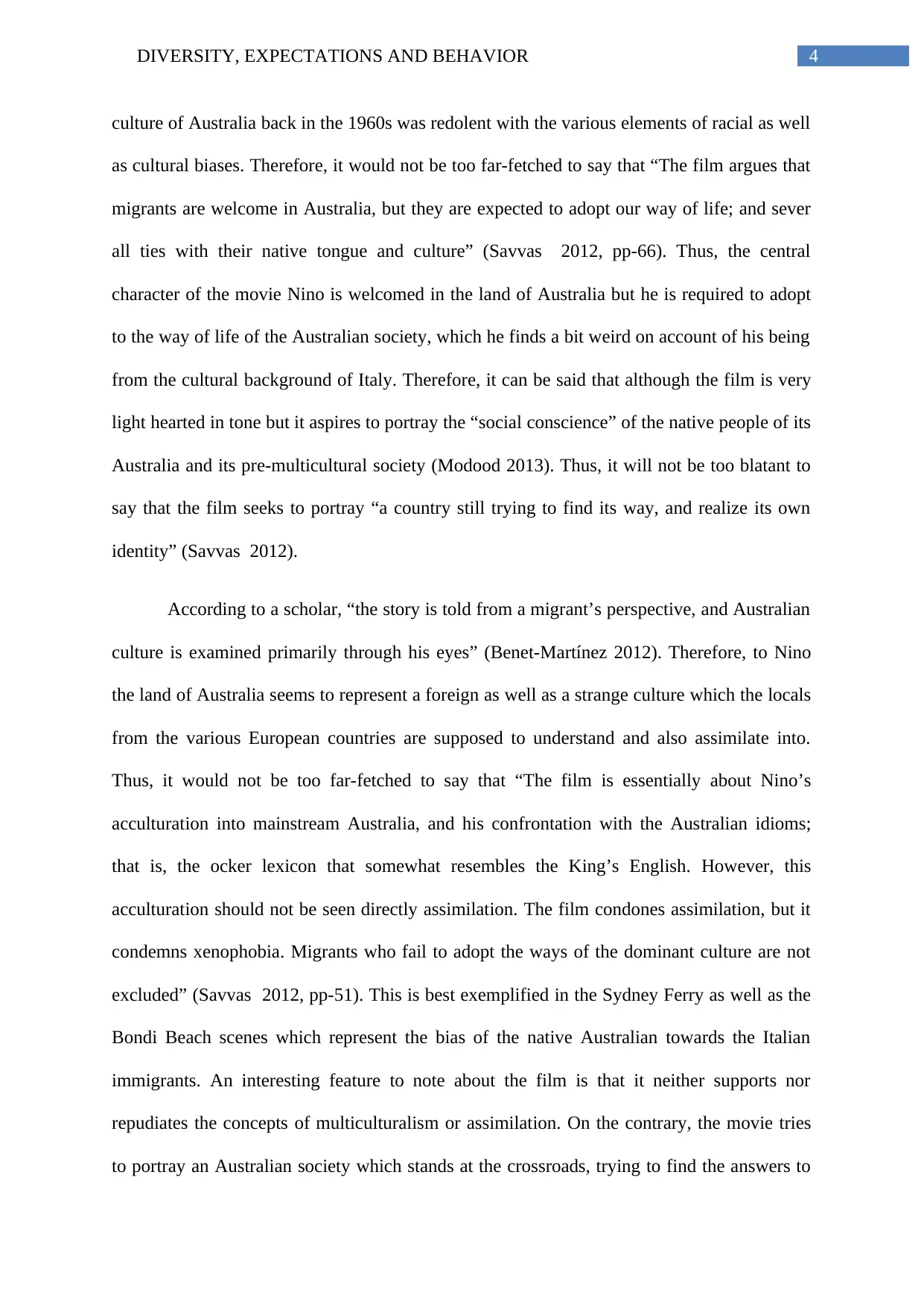
4DIVERSITY, EXPECTATIONS AND BEHAVIOR
culture of Australia back in the 1960s was redolent with the various elements of racial as well
as cultural biases. Therefore, it would not be too far-fetched to say that “The film argues that
migrants are welcome in Australia, but they are expected to adopt our way of life; and sever
all ties with their native tongue and culture” (Savvas 2012, pp-66). Thus, the central
character of the movie Nino is welcomed in the land of Australia but he is required to adopt
to the way of life of the Australian society, which he finds a bit weird on account of his being
from the cultural background of Italy. Therefore, it can be said that although the film is very
light hearted in tone but it aspires to portray the “social conscience” of the native people of its
Australia and its pre-multicultural society (Modood 2013). Thus, it will not be too blatant to
say that the film seeks to portray “a country still trying to find its way, and realize its own
identity” (Savvas 2012).
According to a scholar, “the story is told from a migrant’s perspective, and Australian
culture is examined primarily through his eyes” (Benet-Martínez 2012). Therefore, to Nino
the land of Australia seems to represent a foreign as well as a strange culture which the locals
from the various European countries are supposed to understand and also assimilate into.
Thus, it would not be too far-fetched to say that “The film is essentially about Nino’s
acculturation into mainstream Australia, and his confrontation with the Australian idioms;
that is, the ocker lexicon that somewhat resembles the King’s English. However, this
acculturation should not be seen directly assimilation. The film condones assimilation, but it
condemns xenophobia. Migrants who fail to adopt the ways of the dominant culture are not
excluded” (Savvas 2012, pp-51). This is best exemplified in the Sydney Ferry as well as the
Bondi Beach scenes which represent the bias of the native Australian towards the Italian
immigrants. An interesting feature to note about the film is that it neither supports nor
repudiates the concepts of multiculturalism or assimilation. On the contrary, the movie tries
to portray an Australian society which stands at the crossroads, trying to find the answers to
culture of Australia back in the 1960s was redolent with the various elements of racial as well
as cultural biases. Therefore, it would not be too far-fetched to say that “The film argues that
migrants are welcome in Australia, but they are expected to adopt our way of life; and sever
all ties with their native tongue and culture” (Savvas 2012, pp-66). Thus, the central
character of the movie Nino is welcomed in the land of Australia but he is required to adopt
to the way of life of the Australian society, which he finds a bit weird on account of his being
from the cultural background of Italy. Therefore, it can be said that although the film is very
light hearted in tone but it aspires to portray the “social conscience” of the native people of its
Australia and its pre-multicultural society (Modood 2013). Thus, it will not be too blatant to
say that the film seeks to portray “a country still trying to find its way, and realize its own
identity” (Savvas 2012).
According to a scholar, “the story is told from a migrant’s perspective, and Australian
culture is examined primarily through his eyes” (Benet-Martínez 2012). Therefore, to Nino
the land of Australia seems to represent a foreign as well as a strange culture which the locals
from the various European countries are supposed to understand and also assimilate into.
Thus, it would not be too far-fetched to say that “The film is essentially about Nino’s
acculturation into mainstream Australia, and his confrontation with the Australian idioms;
that is, the ocker lexicon that somewhat resembles the King’s English. However, this
acculturation should not be seen directly assimilation. The film condones assimilation, but it
condemns xenophobia. Migrants who fail to adopt the ways of the dominant culture are not
excluded” (Savvas 2012, pp-51). This is best exemplified in the Sydney Ferry as well as the
Bondi Beach scenes which represent the bias of the native Australian towards the Italian
immigrants. An interesting feature to note about the film is that it neither supports nor
repudiates the concepts of multiculturalism or assimilation. On the contrary, the movie tries
to portray an Australian society which stands at the crossroads, trying to find the answers to
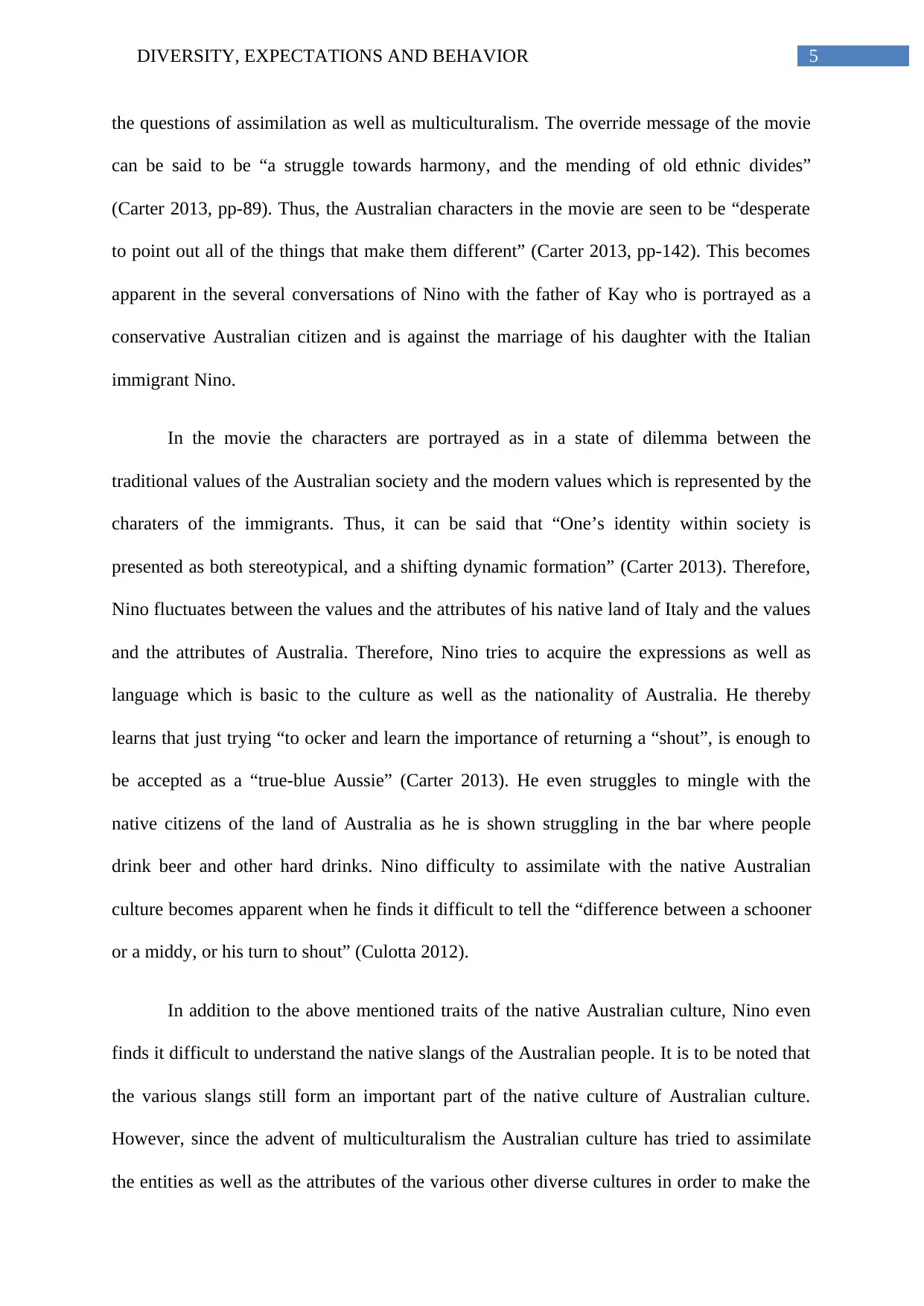
5DIVERSITY, EXPECTATIONS AND BEHAVIOR
the questions of assimilation as well as multiculturalism. The override message of the movie
can be said to be “a struggle towards harmony, and the mending of old ethnic divides”
(Carter 2013, pp-89). Thus, the Australian characters in the movie are seen to be “desperate
to point out all of the things that make them different” (Carter 2013, pp-142). This becomes
apparent in the several conversations of Nino with the father of Kay who is portrayed as a
conservative Australian citizen and is against the marriage of his daughter with the Italian
immigrant Nino.
In the movie the characters are portrayed as in a state of dilemma between the
traditional values of the Australian society and the modern values which is represented by the
charaters of the immigrants. Thus, it can be said that “One’s identity within society is
presented as both stereotypical, and a shifting dynamic formation” (Carter 2013). Therefore,
Nino fluctuates between the values and the attributes of his native land of Italy and the values
and the attributes of Australia. Therefore, Nino tries to acquire the expressions as well as
language which is basic to the culture as well as the nationality of Australia. He thereby
learns that just trying “to ocker and learn the importance of returning a “shout”, is enough to
be accepted as a “true-blue Aussie” (Carter 2013). He even struggles to mingle with the
native citizens of the land of Australia as he is shown struggling in the bar where people
drink beer and other hard drinks. Nino difficulty to assimilate with the native Australian
culture becomes apparent when he finds it difficult to tell the “difference between a schooner
or a middy, or his turn to shout” (Culotta 2012).
In addition to the above mentioned traits of the native Australian culture, Nino even
finds it difficult to understand the native slangs of the Australian people. It is to be noted that
the various slangs still form an important part of the native culture of Australian culture.
However, since the advent of multiculturalism the Australian culture has tried to assimilate
the entities as well as the attributes of the various other diverse cultures in order to make the
the questions of assimilation as well as multiculturalism. The override message of the movie
can be said to be “a struggle towards harmony, and the mending of old ethnic divides”
(Carter 2013, pp-89). Thus, the Australian characters in the movie are seen to be “desperate
to point out all of the things that make them different” (Carter 2013, pp-142). This becomes
apparent in the several conversations of Nino with the father of Kay who is portrayed as a
conservative Australian citizen and is against the marriage of his daughter with the Italian
immigrant Nino.
In the movie the characters are portrayed as in a state of dilemma between the
traditional values of the Australian society and the modern values which is represented by the
charaters of the immigrants. Thus, it can be said that “One’s identity within society is
presented as both stereotypical, and a shifting dynamic formation” (Carter 2013). Therefore,
Nino fluctuates between the values and the attributes of his native land of Italy and the values
and the attributes of Australia. Therefore, Nino tries to acquire the expressions as well as
language which is basic to the culture as well as the nationality of Australia. He thereby
learns that just trying “to ocker and learn the importance of returning a “shout”, is enough to
be accepted as a “true-blue Aussie” (Carter 2013). He even struggles to mingle with the
native citizens of the land of Australia as he is shown struggling in the bar where people
drink beer and other hard drinks. Nino difficulty to assimilate with the native Australian
culture becomes apparent when he finds it difficult to tell the “difference between a schooner
or a middy, or his turn to shout” (Culotta 2012).
In addition to the above mentioned traits of the native Australian culture, Nino even
finds it difficult to understand the native slangs of the Australian people. It is to be noted that
the various slangs still form an important part of the native culture of Australian culture.
However, since the advent of multiculturalism the Australian culture has tried to assimilate
the entities as well as the attributes of the various other diverse cultures in order to make the
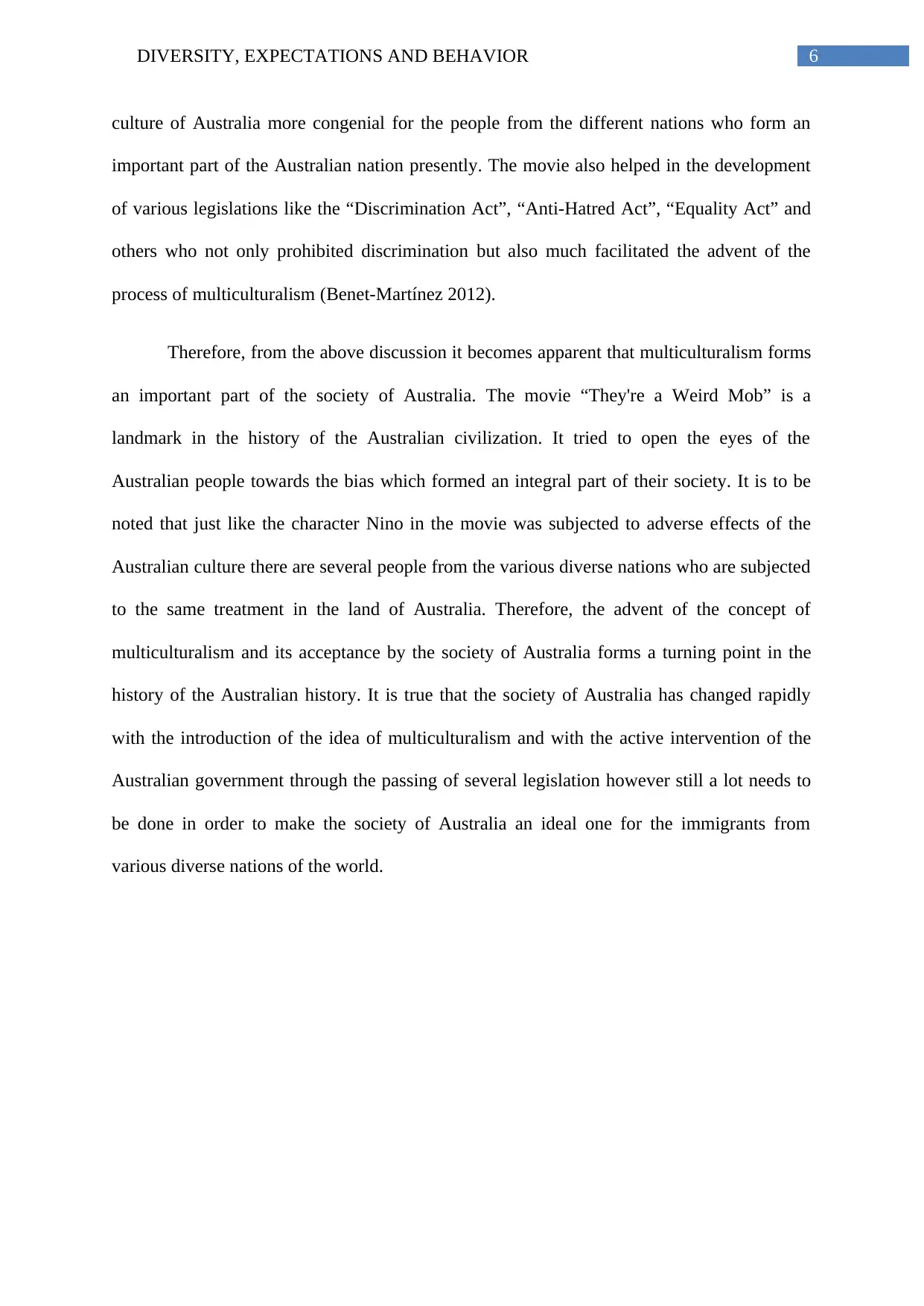
6DIVERSITY, EXPECTATIONS AND BEHAVIOR
culture of Australia more congenial for the people from the different nations who form an
important part of the Australian nation presently. The movie also helped in the development
of various legislations like the “Discrimination Act”, “Anti-Hatred Act”, “Equality Act” and
others who not only prohibited discrimination but also much facilitated the advent of the
process of multiculturalism (Benet-Martínez 2012).
Therefore, from the above discussion it becomes apparent that multiculturalism forms
an important part of the society of Australia. The movie “They're a Weird Mob” is a
landmark in the history of the Australian civilization. It tried to open the eyes of the
Australian people towards the bias which formed an integral part of their society. It is to be
noted that just like the character Nino in the movie was subjected to adverse effects of the
Australian culture there are several people from the various diverse nations who are subjected
to the same treatment in the land of Australia. Therefore, the advent of the concept of
multiculturalism and its acceptance by the society of Australia forms a turning point in the
history of the Australian history. It is true that the society of Australia has changed rapidly
with the introduction of the idea of multiculturalism and with the active intervention of the
Australian government through the passing of several legislation however still a lot needs to
be done in order to make the society of Australia an ideal one for the immigrants from
various diverse nations of the world.
culture of Australia more congenial for the people from the different nations who form an
important part of the Australian nation presently. The movie also helped in the development
of various legislations like the “Discrimination Act”, “Anti-Hatred Act”, “Equality Act” and
others who not only prohibited discrimination but also much facilitated the advent of the
process of multiculturalism (Benet-Martínez 2012).
Therefore, from the above discussion it becomes apparent that multiculturalism forms
an important part of the society of Australia. The movie “They're a Weird Mob” is a
landmark in the history of the Australian civilization. It tried to open the eyes of the
Australian people towards the bias which formed an integral part of their society. It is to be
noted that just like the character Nino in the movie was subjected to adverse effects of the
Australian culture there are several people from the various diverse nations who are subjected
to the same treatment in the land of Australia. Therefore, the advent of the concept of
multiculturalism and its acceptance by the society of Australia forms a turning point in the
history of the Australian history. It is true that the society of Australia has changed rapidly
with the introduction of the idea of multiculturalism and with the active intervention of the
Australian government through the passing of several legislation however still a lot needs to
be done in order to make the society of Australia an ideal one for the immigrants from
various diverse nations of the world.
Paraphrase This Document
Need a fresh take? Get an instant paraphrase of this document with our AI Paraphraser
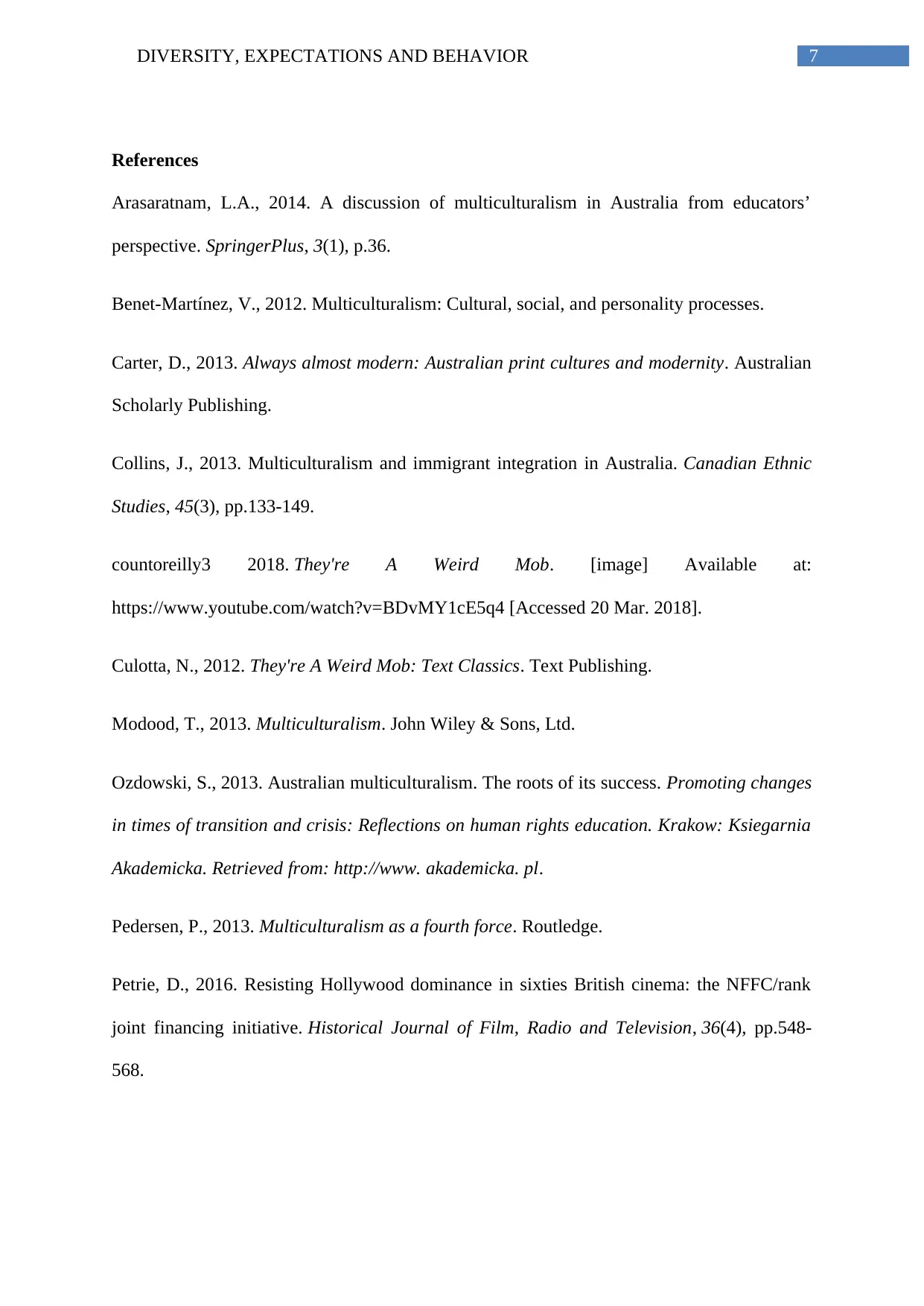
7DIVERSITY, EXPECTATIONS AND BEHAVIOR
References
Arasaratnam, L.A., 2014. A discussion of multiculturalism in Australia from educators’
perspective. SpringerPlus, 3(1), p.36.
Benet-Martínez, V., 2012. Multiculturalism: Cultural, social, and personality processes.
Carter, D., 2013. Always almost modern: Australian print cultures and modernity. Australian
Scholarly Publishing.
Collins, J., 2013. Multiculturalism and immigrant integration in Australia. Canadian Ethnic
Studies, 45(3), pp.133-149.
countoreilly3 2018. They're A Weird Mob. [image] Available at:
https://www.youtube.com/watch?v=BDvMY1cE5q4 [Accessed 20 Mar. 2018].
Culotta, N., 2012. They're A Weird Mob: Text Classics. Text Publishing.
Modood, T., 2013. Multiculturalism. John Wiley & Sons, Ltd.
Ozdowski, S., 2013. Australian multiculturalism. The roots of its success. Promoting changes
in times of transition and crisis: Reflections on human rights education. Krakow: Ksiegarnia
Akademicka. Retrieved from: http://www. akademicka. pl.
Pedersen, P., 2013. Multiculturalism as a fourth force. Routledge.
Petrie, D., 2016. Resisting Hollywood dominance in sixties British cinema: the NFFC/rank
joint financing initiative. Historical Journal of Film, Radio and Television, 36(4), pp.548-
568.
References
Arasaratnam, L.A., 2014. A discussion of multiculturalism in Australia from educators’
perspective. SpringerPlus, 3(1), p.36.
Benet-Martínez, V., 2012. Multiculturalism: Cultural, social, and personality processes.
Carter, D., 2013. Always almost modern: Australian print cultures and modernity. Australian
Scholarly Publishing.
Collins, J., 2013. Multiculturalism and immigrant integration in Australia. Canadian Ethnic
Studies, 45(3), pp.133-149.
countoreilly3 2018. They're A Weird Mob. [image] Available at:
https://www.youtube.com/watch?v=BDvMY1cE5q4 [Accessed 20 Mar. 2018].
Culotta, N., 2012. They're A Weird Mob: Text Classics. Text Publishing.
Modood, T., 2013. Multiculturalism. John Wiley & Sons, Ltd.
Ozdowski, S., 2013. Australian multiculturalism. The roots of its success. Promoting changes
in times of transition and crisis: Reflections on human rights education. Krakow: Ksiegarnia
Akademicka. Retrieved from: http://www. akademicka. pl.
Pedersen, P., 2013. Multiculturalism as a fourth force. Routledge.
Petrie, D., 2016. Resisting Hollywood dominance in sixties British cinema: the NFFC/rank
joint financing initiative. Historical Journal of Film, Radio and Television, 36(4), pp.548-
568.
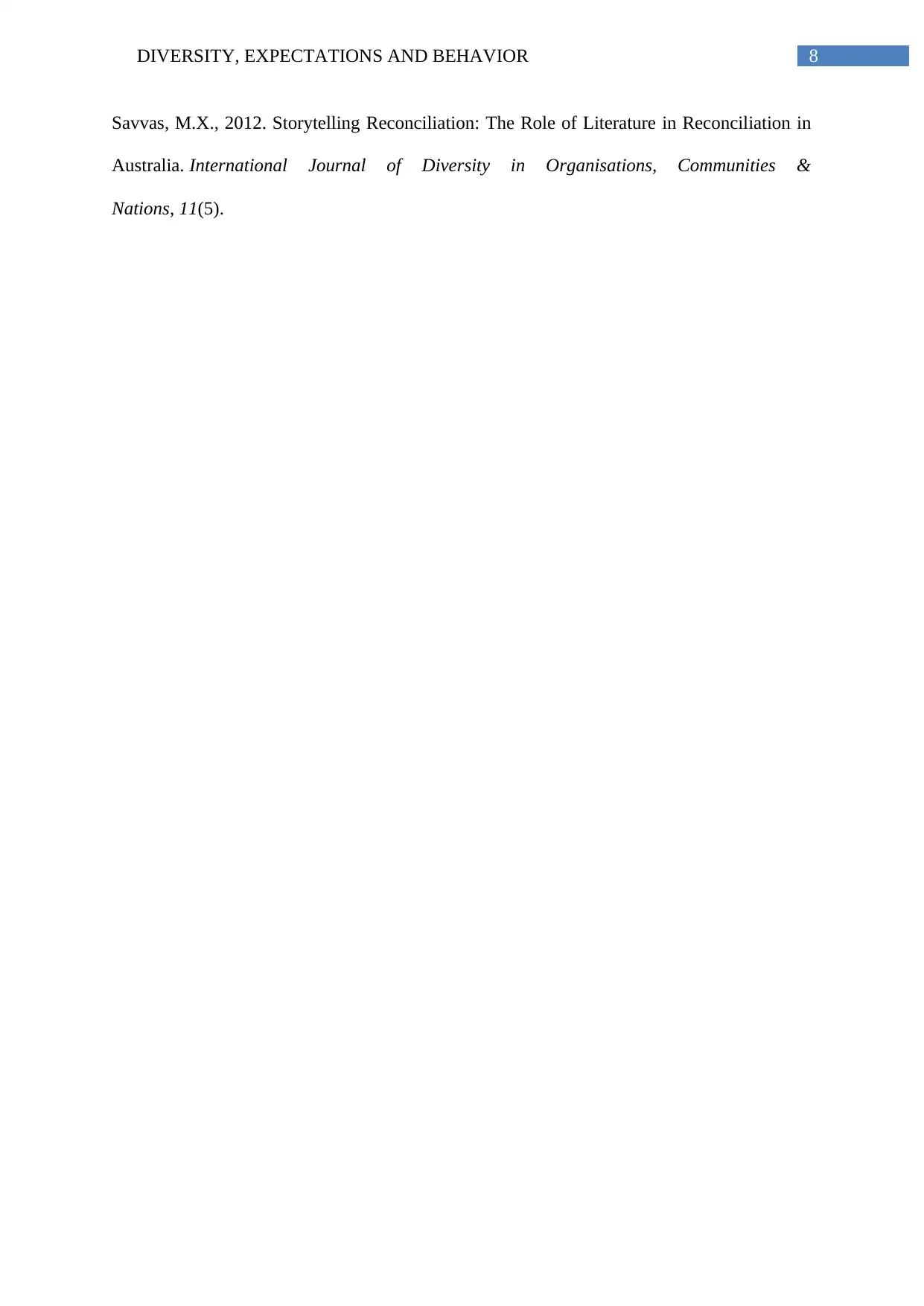
8DIVERSITY, EXPECTATIONS AND BEHAVIOR
Savvas, M.X., 2012. Storytelling Reconciliation: The Role of Literature in Reconciliation in
Australia. International Journal of Diversity in Organisations, Communities &
Nations, 11(5).
Savvas, M.X., 2012. Storytelling Reconciliation: The Role of Literature in Reconciliation in
Australia. International Journal of Diversity in Organisations, Communities &
Nations, 11(5).
1 out of 9
Related Documents
Your All-in-One AI-Powered Toolkit for Academic Success.
+13062052269
info@desklib.com
Available 24*7 on WhatsApp / Email
![[object Object]](/_next/static/media/star-bottom.7253800d.svg)
Unlock your academic potential
© 2024 | Zucol Services PVT LTD | All rights reserved.



